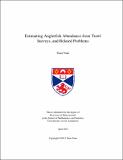Files in this item
Estimating anglerfish abundance from trawl surveys, and related problems
Item metadata
| dc.contributor.advisor | Borchers, D. L. | |
| dc.contributor.author | Yuan, Yuan | |
| dc.coverage.spatial | vii, 220 p. | en_US |
| dc.date.accessioned | 2013-06-10T13:12:48Z | |
| dc.date.available | 2013-06-10T13:12:48Z | |
| dc.date.issued | 2012 | |
| dc.identifier | uk.bl.ethos.574769 | |
| dc.identifier.uri | https://hdl.handle.net/10023/3652 | |
| dc.description.abstract | The content of this thesis was motivated by the need to estimate anglerfish abundance from stratified random trawl surveys of the anglerfish stock which occupies the northern European shelf (Fernandes et al., 2007). The survey was conducted annually from 2005 to 2010 in order to obtain age-structured estimates of absolute abundance for this stock. An estimation method is considered to incorporate statistical models for herding, length-based net retention probability and missing age data and uncertainty from all of these sources in variance estimation. A key component of abundance estimation is the estimation of capture probability. Capture probability is estimated from the experimental survey data using various logistic regression models with haul as a random effect. Conditional on the estimated capture probability, a number of abundance estimators are developed and applied to the anglerfish data. The abundance estimators differ in the way that the haul effect is incorporated. The performance of these estimators is investigated by simulation. An estimator with form similar to that conventionally used to estimate abundance from distance sampling surveys is found to perform best. The estimators developed for the anglerfish survey data which incorporate random effects in capture probability have wider application than trawl surveys. We examine the analytic properties of these estimators when the capture/detection probability is known. We apply these estimators to three different types of survey data in addition to the anglerfish data, with different forms of random effects and investigate their performance by simulation. We find that a generalization of the form of estimator typically used on line transect surveys performs best overall. It has low bias, and also the lowest bias and mean squared error among all the estimators we considered. | en_US |
| dc.language.iso | en | en_US |
| dc.publisher | University of St Andrews | |
| dc.subject.lcc | QL637.9L6Y8 | |
| dc.subject.lcsh | Anglerfishes--Population viability analysis--Statistical methods | en_US |
| dc.title | Estimating anglerfish abundance from trawl surveys, and related problems | en_US |
| dc.type | Thesis | en_US |
| dc.contributor.sponsor | Marine Scotland Science | en_US |
| dc.type.qualificationlevel | Doctoral | en_US |
| dc.type.qualificationname | PhD Doctor of Philosophy | en_US |
| dc.publisher.institution | The University of St Andrews | en_US |
This item appears in the following Collection(s)
Items in the St Andrews Research Repository are protected by copyright, with all rights reserved, unless otherwise indicated.

